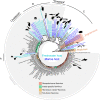Aquatic Flaviviruses
- PMID: 35975997
- PMCID: PMC9472621
- DOI: 10.1128/jvi.00439-22
Aquatic Flaviviruses
Abstract
Flaviviruses are positive-sense single-stranded RNA viruses, including some well-known human pathogens such as Zika, dengue, and yellow fever viruses, which are primarily associated with mosquito and tick vectors. The vast majority of flavivirus research has focused on terrestrial environments; however, recent findings indicate that a range of flaviviruses are also present in aquatic environments, both marine and freshwater. These flaviviruses are found in various hosts, including fish, crustaceans, molluscs, and echinoderms. Although the effects of aquatic flaviviruses on the hosts they infect are not all known, some have been detected in farmed species and may have detrimental effects on the aquaculture industry. Exploration of the evolutionary history through the discovery of the Wenzhou shark flavivirus in both a shark and crab host is of particular interest since the potential dual-host nature of this virus may indicate that the invertebrate-vertebrate relationship seen in other flaviviruses may have a more profound evolutionary root than previously expected. Potential endogenous viral elements and the range of novel aquatic flaviviruses discovered thus shed light on virus origins and evolutionary history and may indicate that, like terrestrial life, the origins of flaviviruses may lie in aquatic environments.
Keywords: Flaviviridae; aquatic virology; evolutionary history; flavivirus; marine virology.
Conflict of interest statement
The authors declare no conflict of interest.
Figures

Similar articles
-
Discovery of Novel Crustacean and Cephalopod Flaviviruses: Insights into the Evolution and Circulation of Flaviviruses between Marine Invertebrate and Vertebrate Hosts.J Virol. 2019 Jun 28;93(14):e00432-19. doi: 10.1128/JVI.00432-19. Print 2019 Jul 15. J Virol. 2019. PMID: 31068424 Free PMC article.
-
Insect-specific flaviviruses, a worldwide widespread group of viruses only detected in insects.Infect Genet Evol. 2016 Jun;40:381-388. doi: 10.1016/j.meegid.2015.07.032. Epub 2015 Jul 31. Infect Genet Evol. 2016. PMID: 26235844
-
Rapid identification of vector-borne flaviviruses by mass spectrometry.Mol Cell Probes. 2010 Aug;24(4):219-28. doi: 10.1016/j.mcp.2010.04.003. Epub 2010 Apr 20. Mol Cell Probes. 2010. PMID: 20412852
-
Lipids and flaviviruses, present and future perspectives for the control of dengue, Zika, and West Nile viruses.Prog Lipid Res. 2016 Oct;64:123-137. doi: 10.1016/j.plipres.2016.09.005. Epub 2016 Oct 1. Prog Lipid Res. 2016. PMID: 27702593 Review.
-
Historical Perspectives on Flavivirus Research.Viruses. 2017 Apr 30;9(5):97. doi: 10.3390/v9050097. Viruses. 2017. PMID: 28468299 Free PMC article. Review.
Cited by
-
Isopods infesting Atlantic bonefish (Albula vulpes) host novel viruses, including reoviruses related to global pathogens, and opportunistically feed on humans.Parasitology. 2024 Oct;151(12):1386-1396. doi: 10.1017/S003118202400146X. Epub 2024 Nov 20. Parasitology. 2024. PMID: 39563628 Free PMC article.
-
A novel tamanavirus (Flaviviridae) of the European common frog (Rana temporaria) from the UK.J Gen Virol. 2023 Dec;104(12):001927. doi: 10.1099/jgv.0.001927. J Gen Virol. 2023. PMID: 38059479 Free PMC article.
-
Knowns and unknowns of TiLV-associated neuronal disease.Virulence. 2024 Dec;15(1):2329568. doi: 10.1080/21505594.2024.2329568. Epub 2024 Mar 31. Virulence. 2024. PMID: 38555518 Free PMC article. Review.
-
Transcriptome mining extends the host range of the Flaviviridae to non-bilaterians.Virus Evol. 2022 Dec 26;9(1):veac124. doi: 10.1093/ve/veac124. eCollection 2023. Virus Evol. 2022. PMID: 36694816 Free PMC article.
-
Assessment of flavivirus RNA stability and infectivity in various water environments.Trop Med Health. 2025 Jan 24;53(1):11. doi: 10.1186/s41182-025-00686-9. Trop Med Health. 2025. PMID: 39856772 Free PMC article.
References
-
- Lindenbach BD, Thiel HJ, Rice CM. 2007. Flaviviridae: the viruses and their replication, p 1101–1152. In Fields virology, 5th ed. Lippincott/Williams & Wilkins, Philadelphia, PA.
-
- Moureau G, Cook S, Lemey P, Nougairede A, Forrester NL, Khasnatinov M, Charrel RN, Firth AE, Gould EA, de Lamballerie X. 2015. New insights into flavivirus evolution, taxonomy and biogeographic history, extended by analysis of canonical and alternative coding sequences. PLoS One 10:e0117849. 10.1371/journal.pone.0117849. - DOI - PMC - PubMed
Publication types
MeSH terms
LinkOut - more resources
Full Text Sources
Miscellaneous

